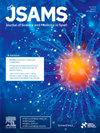儿童简单运动能力测验(SMC-Kids)的效度和信度。
IF 3
2区 医学
Q1 SPORT SCIENCES
引用次数: 0
摘要
目的:对儿童简单运动能力测验(SMC-Kids)的效度和信度进行检验。设计:横断面和重复测量设计。方法:对71名4 ~ 岁儿童进行大肌肉运动发展测试-3 (TGMD-3)和SMC-Kids(10 m穿梭跑和扔纸球)的效度评估。为了评估者之间的信度,91名年龄在3-6 岁的儿童进行了两次SMC-Kids测试,由两个不同的评估者进行。为了评估评分者内部的可靠性和量化测量误差之外的改进,53名参与者在7-10 天后由同一评分者重新评估。结果:10 m穿梭跑与TGMD-3运动得分之间的Spearman's rho为-0.51(95 % CI: -0.31, -0.66),扔纸球与TGMD-3球技能得分之间的Spearman's rho为0.80(95 % CI: 0.70, 0.87)。验证性因子分析显示,10 m飞梭跑和扔纸球与运动和物体控制技能潜变量有较强的相关性,因子负荷分别为-0.97和0.88。两项检验均显示出良至优的评估间信度(ICC = 0.898-0.96)和评估内信度(ICC = 0.882-0.974)。最小值变化为10 m的穿梭跑0.25 s,扔纸球0.42 m,双变异系数分别为0.46 s和0.99 m, MDC 95分别为0.82 s和1.52 m。结论:SMC-Kids是一个简单的工具,可以快速测量学龄前儿童的运动和物体控制技能,不需要特殊的设备或大的空间。本文章由计算机程序翻译,如有差异,请以英文原文为准。
Validity and reliability of the Simple Motor Competence-check for Kids (SMC-Kids)
Objectives
To examine the validity and reliability of the Simple Motor Competence-check for Kids (SMC-Kids), which was developed to assess motor development in preschool children.
Design
A cross-sectional and repeated-measures design.
Methods
To assess validity, 71 children aged 4–6 years completed the Test of Gross Motor Development-3 (TGMD-3) and SMC-Kids (10 m shuttle run and paper ball throw). For inter-rater reliability, 91 children aged 3–6 years performed the SMC-Kids test, twice, by two different raters. To evaluate intra-rater reliability and quantify improvements beyond measurement error, 53 participants were reassessed by the same rater 7–10 days later.
Results
Spearman's rho between the 10 m shuttle run and the TGMD-3 locomotor score was − 0.51 (95 % CI: − 0.31, − 0.66), and between the paper ball throw and TGMD-3 ball skill score was 0.80 (95 % CI: 0.70, 0.87). Confirmatory factor analysis showed strong associations of the 10 m shuttle run and paper ball throw with latent variables of locomotor and object control skills, with factor loadings of − 0.97 and 0.88, respectively. Both tests showed good-to-excellent inter-rater (ICC = 0.898–0.96) and intra-rater reliabilities (ICC = 0.882–0.974). The smallest worthwhile changes were 0.25 s for the 10 m shuttle run and 0.42 m for the paper ball throw, with double coefficients of variation of 0.46 s and 0.99 m, and MDC 95 of 0.82 s and 1.52 m, respectively.
Conclusions
SMC-Kids is a simple tool to quickly measure preschooler locomotor and object control skills without the need for special equipment or large spaces.
求助全文
通过发布文献求助,成功后即可免费获取论文全文。
去求助
来源期刊
CiteScore
7.40
自引率
10.00%
发文量
198
审稿时长
48 days
期刊介绍:
The Journal of Science and Medicine in Sport is the official journal of Sports Medicine Australia (SMA) and is an an international refereed research publication covering all aspects of sport science and medicine.
The Journal considers for publication Original research and Review papers in the sub-disciplines relating generally to the broad sports medicine and sports science fields: sports medicine, sports injury (including injury epidemiology and injury prevention), physiotherapy, podiatry, physical activity and health, sports science, biomechanics, exercise physiology, motor control and learning, sport and exercise psychology, sports nutrition, public health (as relevant to sport and exercise), and rehabilitation and injury management. Manuscripts with an interdisciplinary perspective with specific applications to sport and exercise and its interaction with health will also be considered.

 求助内容:
求助内容: 应助结果提醒方式:
应助结果提醒方式:


